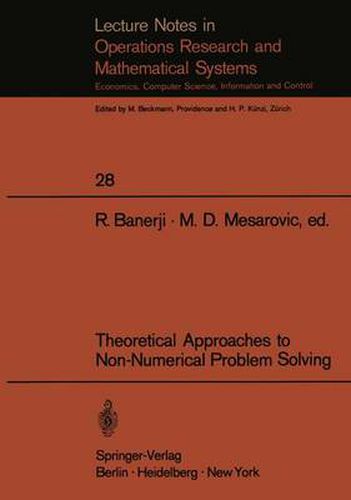Readings Newsletter
Become a Readings Member to make your shopping experience even easier.
Sign in or sign up for free!
You’re not far away from qualifying for FREE standard shipping within Australia
You’ve qualified for FREE standard shipping within Australia
The cart is loading…






This title is printed to order. This book may have been self-published. If so, we cannot guarantee the quality of the content. In the main most books will have gone through the editing process however some may not. We therefore suggest that you be aware of this before ordering this book. If in doubt check either the author or publisher’s details as we are unable to accept any returns unless they are faulty. Please contact us if you have any questions.
Advances in computer technology have pointed out the next important area of computer applications: solution of non-numerical problems. It is hardly necessary to emphasize the importance of these kind of problems. First of all most of the decisions one has to make in real-life situations are non-numerical in the first instance and can be represented as numerical problems only as approximations which are often only partially valid. Second, to use the computer to its full potential it should be employed as a logical machine, capable of deduction, and not just as a numerical calculating machine. Thus the computer would extend man’s capability for logical reasoning and not just for his capability to do fast and accurate calculation. It is not a new area; indeed non-numerical problems are central in fields such as artificial intelligence, heuristic programming, pattern recognition, classification and information-processing (and retrival) etc. However, it is fair to assess that progress in the area has not been quite as expected. One of the reasons was a lack of conceptual and theoretical framework in which to investigate different classes of non-numerical problems to improve understanding of various types of problems and methods for their solutions and furthermore to enable the methods which have been proven as effective in one situation to be used in another situation with appropriately similar structure.
$9.00 standard shipping within Australia
FREE standard shipping within Australia for orders over $100.00
Express & International shipping calculated at checkout
This title is printed to order. This book may have been self-published. If so, we cannot guarantee the quality of the content. In the main most books will have gone through the editing process however some may not. We therefore suggest that you be aware of this before ordering this book. If in doubt check either the author or publisher’s details as we are unable to accept any returns unless they are faulty. Please contact us if you have any questions.
Advances in computer technology have pointed out the next important area of computer applications: solution of non-numerical problems. It is hardly necessary to emphasize the importance of these kind of problems. First of all most of the decisions one has to make in real-life situations are non-numerical in the first instance and can be represented as numerical problems only as approximations which are often only partially valid. Second, to use the computer to its full potential it should be employed as a logical machine, capable of deduction, and not just as a numerical calculating machine. Thus the computer would extend man’s capability for logical reasoning and not just for his capability to do fast and accurate calculation. It is not a new area; indeed non-numerical problems are central in fields such as artificial intelligence, heuristic programming, pattern recognition, classification and information-processing (and retrival) etc. However, it is fair to assess that progress in the area has not been quite as expected. One of the reasons was a lack of conceptual and theoretical framework in which to investigate different classes of non-numerical problems to improve understanding of various types of problems and methods for their solutions and furthermore to enable the methods which have been proven as effective in one situation to be used in another situation with appropriately similar structure.